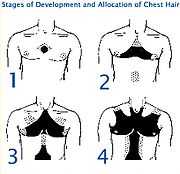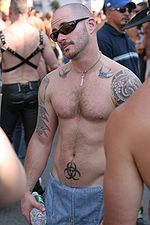
Chest hair
Encyclopedia

Hair
Hair is a filamentous biomaterial, that grows from follicles found in the dermis. Found exclusively in mammals, hair is one of the defining characteristics of the mammalian class....
that grows on the chest
Chest
The chest is a part of the anatomy of humans and various other animals. It is sometimes referred to as the thorax or the bosom.-Chest anatomy - Humans and other hominids:...
of human males, in the region between the neck
Neck
The neck is the part of the body, on many terrestrial or secondarily aquatic vertebrates, that distinguishes the head from the torso or trunk. The adjective signifying "of the neck" is cervical .-Boner anatomy: The cervical spine:The cervical portion of the human spine comprises seven boney...
and the abdomen. Chest hair, which is a secondary sex characteristic
Secondary sex characteristic
Secondary sex characteristics are features that distinguish the two sexes of a species, but that are not directly part of the reproductive system. They are believed to be the product of sexual selection for traits which give an individual an advantage over its rivals in courtship and aggressive...
, develops during and after puberty
Puberty
Puberty is the process of physical changes by which a child's body matures into an adult body capable of reproduction, as initiated by hormonal signals from the brain to the gonads; the ovaries in a girl, the testes in a boy...
. It is therefore part of the androgenic hair
Androgenic hair
Androgenic hair, colloquially body hair, is the terminal hair that develops on the body during and after puberty. It is differentiated from the head hair and less visible vellus hair, which are much finer and lighter in color. The growth of androgenic hair is related to the level of androgens in...
.
Development and growth
Although vellus hair is already present in the area in childhood, the term chest hair is generally restricted to the terminal hairTerminal hair
Terminal hairs are thick, long, and dark, as compared with vellus hair. During puberty, the increase in androgenic hormone levels causes vellus hair to be replaced with terminal hair in certain parts of the human body...
that develops as an effect of rising levels of androgens (primarily testosterone
Testosterone
Testosterone is a steroid hormone from the androgen group and is found in mammals, reptiles, birds, and other vertebrates. In mammals, testosterone is primarily secreted in the testes of males and the ovaries of females, although small amounts are also secreted by the adrenal glands...
and its derivatives) due to puberty
Puberty
Puberty is the process of physical changes by which a child's body matures into an adult body capable of reproduction, as initiated by hormonal signals from the brain to the gonads; the ovaries in a girl, the testes in a boy...
. Different from the head hair it is therefore a secondary sexual characteristic. Men tend to be covered with far more terminal hair, particularly on the chest, the abdomen
Abdominal hair
The term abdominal hair refers to the hair that grows on the abdomen of humans and non-human mammals, in the region between the pubic area and the thorax . The growth of abdominal hair follows the same pattern on nearly all mammals, vertically from the pubic area upwards and from the thorax...
and the face
Facial hair
Facial hair is a secondary sex characteristic of human males. Men often start developing facial hair in the later years of puberty or adolescence, approximately between 17–20 years of age, and most do not finish developing a fully adult beard until their early 20s or even later...
.
The development of chest hair begins normally during late puberty, usually between the ages of 15 and 18. It can also start later, between the age of 20 and 30, so that many men in their twenties have not yet reached their full chest hair development. The growth continues subsequently. In older adult years androgens cause thickening of the hair.
Patterns and characteristics



Gene
A gene is a molecular unit of heredity of a living organism. It is a name given to some stretches of DNA and RNA that code for a type of protein or for an RNA chain that has a function in the organism. Living beings depend on genes, as they specify all proteins and functional RNA chains...
tic disposition, the hormonal status and the age of the person. The gene
Gene
A gene is a molecular unit of heredity of a living organism. It is a name given to some stretches of DNA and RNA that code for a type of protein or for an RNA chain that has a function in the organism. Living beings depend on genes, as they specify all proteins and functional RNA chains...
s primarily determine the amount, patterns and thickness of chest hair. Some men are very hairy, while others have no chest hair at all. All ranges and patterns of hair growth are normal. The areas where terminal hair may grow are the periareolar areas (nipple
Nipple
In its most general form, a nipple is a structure from which a fluid emanates. More specifically, it is the projection on the breasts or udder of a mammal by which breast milk is delivered to a mother's young. In this sense, it is often called a teat, especially when referring to non-humans, and...
s), the centre and sides of the chest and the clavicle
Clavicle
In human anatomy, the clavicle or collar bone is a long bone of short length that serves as a strut between the scapula and the sternum. It is the only long bone in body that lies horizontally...
(collarbone).
The direction of growth of hair can make for interesting patterns, akin to depictions of mathematical vector fields. Typical males will exhibit a node on the upper sternum, the hair above which points up and the hair below which points down. Some individuals (of, say, the pattern in diagram 3) have spirals on their upper pectoral regions (several inches from the nipple towards the neck) which run clockwise on the left breast and counter-clockwise on the right.
Considering an individual occurrence of chest hair as abnormal is usually not due to medical indications but primarily to cultural and social attitudes. An excessive growth of terminal hair on the body of men and women is called hypertrichosis
Hypertrichosis
Hypertrichosis is an abnormal amount of hair growth on the body; extensive cases of hypertrichosis have informally been called werewolf syndrome. There are two distinct types of hypertrichosis: generalized hypertrichosis, which occurs over the entire body, and localized hypertrichosis, which is...
. This medical term has to be distinguished from hirsutism
Hirsutism
Hirsutism or frazonism is the excessive hairiness on women in those parts of the body where terminal hair does not normally occur or is minimal - for example, a beard or chest hair. It refers to a male pattern of body hair and it is therefore primarily of cosmetic and psychological concern...
that just affects women. These women can develop terminal hair on the chest following the male pattern as a symptom of an endocrine disease.
There have been occasional studies documenting patterns of chest hair in men and occurrence of these patterns. A study of 1100 men aged 17 to 71 defined and documented ten patterns of chest hair in Caucasoid men. In this study 6 percent of the men were found to have no chest hair. The largest group, 56 percent, displayed pattern four as shown in the accompanying figure. The remaining 38 percent of the men displayed a lesser quantity of chest hair. Seven percent displayed pattern one, 13 percent displayed pattern two and 18 percent displayed various other patterns.
The same study documented the chest hair patterns of 60 African-American men aged 20-40. For these men 22 percent were found to have no chest hair. The largest group, 37 percent displayed pattern four and the remaining 41 percent had a lesser quantity of chest hair. Eight percent displayed pattern one, 12 percent pattern two and 11 percent displayed various other patterns.

